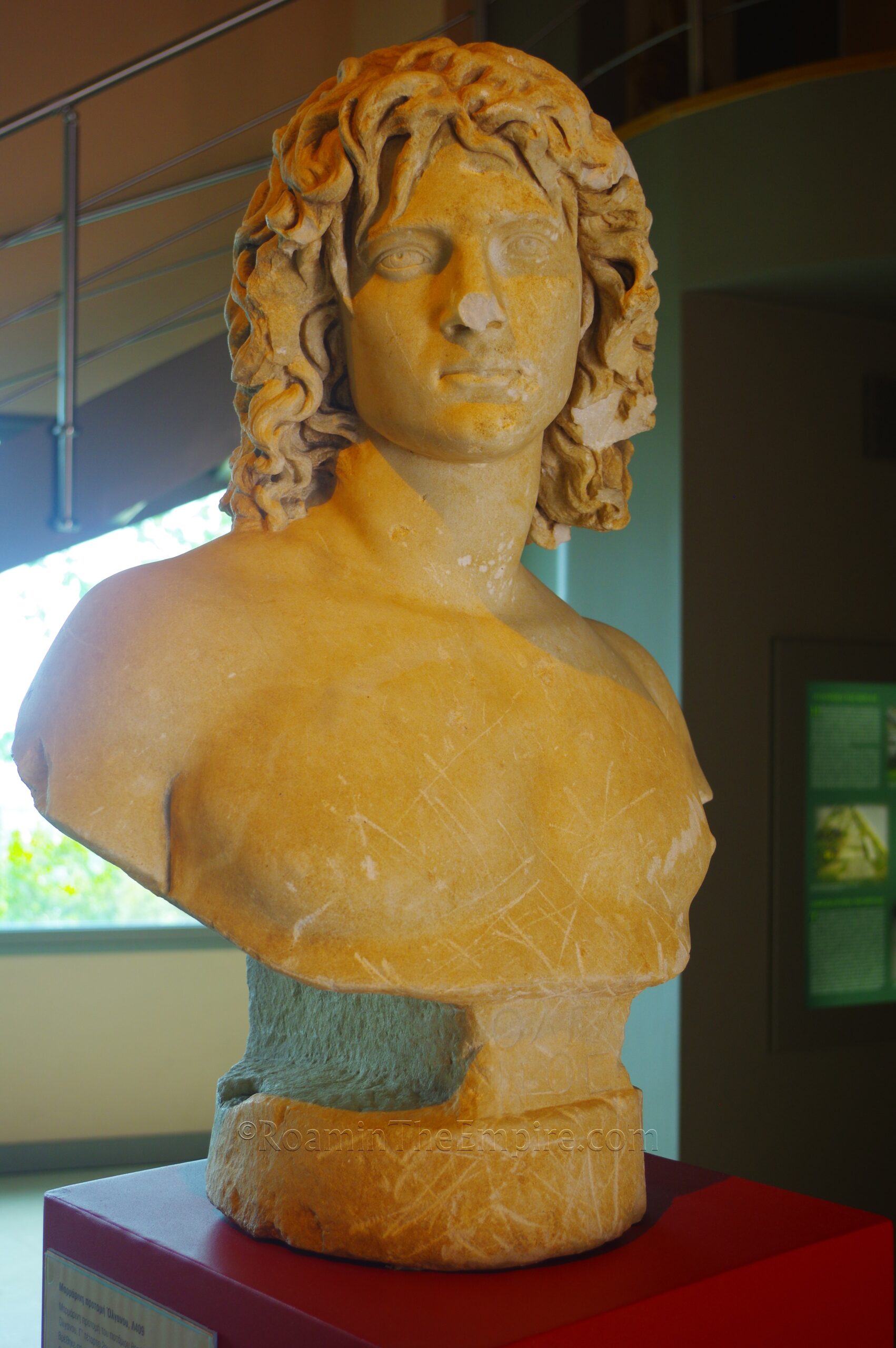
Most Recent Visit: May 2024
The ancient city of Beroea (also Berea or Beroia) was located in Macedonia at the foot of the mountain of Bermion (modern Vermio Mountains) on the banks of the longest river in Greece, the Haliakmon. Today the modern town of Veria occupies the site of its ancient predecessor. According to legend, the city was founded by the mythical king Beres (himself the son of the legendary Makedon, progenitor of the Macedonian people) and named after his daughter Beroia. Archaeologically, there is evidence of settlement at the site of Beroea since at least the 10th century BCE and continuously more or less to the present day.
Beroea is first mentioned by Thucydides one of a number of cities in the area the Athenians attempted to besiege. Unsuccessful at Beroea, the Athenians moved on to Potidaea (though there is some conjecture as to whether there was another city with this name that is the actual subject of the passage). Even though the most prominent city in Macedonia changed over time (first Edessa, then Pella, and finally Thessaloniki), Beroea seems to have always maintained a position as the second most important city in the region, and prospered under the Argeads. It was at Beroea in 288 BCE that the whole of the Macedonian army defected from Demetrius I Poliorcetes to Pyrrhus of Epirus.

The city was apparently flourishing from that point on through the Third Macedonian War with the Romans. Following the Roman victory over Philip V of Macedon at Pydna in 168 BCE, Beroea was reportedly one of the first cities to submit to the Romans. When the Macedonia was subdivided into the four client merides, Beroea did not become one of the capitals, but by the time of Augustus had become the seat of the Macedonian Koinon and continued to enjoy some degree of prosperity. Sometime during the brief reign of Nerva, the city sent one Gaius Popillius Python, a member of the Koinon, to petition that the titles of metropolis and neokoros be given to the city, which he achieved. Philip the Arab is reported to have visited the city in 244 CE. During the 3rd century CE, games honoring Alexander the Great, the Alexandreia, seem to have been held in Beroea. Around this time, the city seems to have entered a period of decline, likely induced by the incursions of the Goths and Heruli in the second half of the 3rd century CE.
Getting There: Like many places in Greece, you’re mostly limited bus travel, which can sometimes be rather confusing and with poorly updated information online. I traveled by car to Veria (there is a good free parking lot north of the city center I have marked) but there is also apparently a KTEL bus line that runs fairly regularly (about once an hour most days) between Thessaoloniki’s Makedonia bus station and Veria. The journey takes about 1.5 hours each way and is currently 7.40 Euro each way or 11 Euro for a return ticket. Up to date pricing and schedules can be found here.
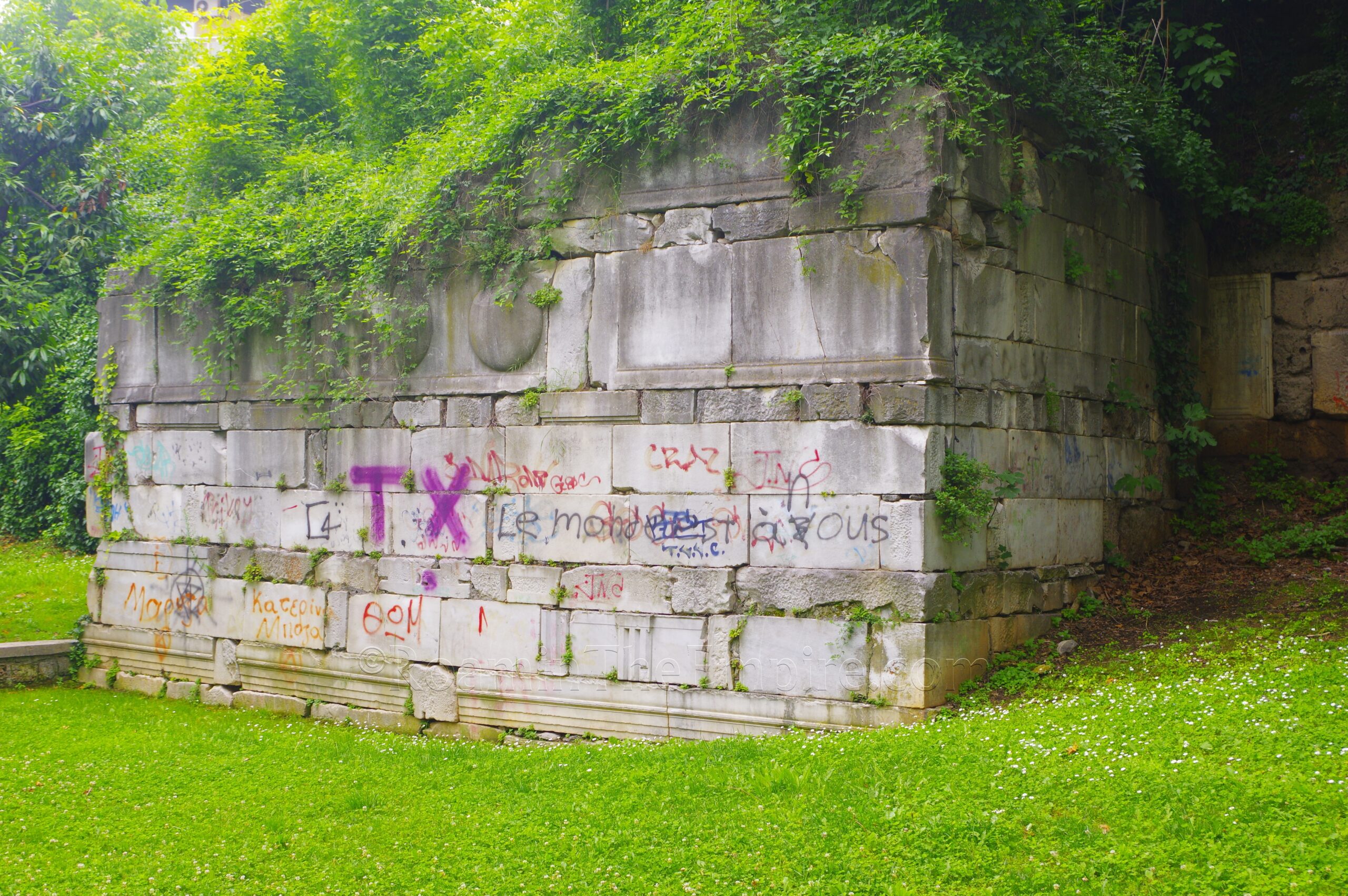
Perhaps the best place to start, as I did, is the northernmost ancient point, conveniently located near the free municipal parking lot. Starting right across the street from the parking lot along Eleftherios Venizelos/Thessalonikis streets are a couple sections of the northern fortification walls of Beroea. While there are apparently some bits of the fortification walls dated as early as the 4th century BCE, this northern section seems to mostly date a bit later to the 3rd century BCE. The fortification walls of the city were rebuilt and reinforced in the 3rd and 4th centuries CE as well as in the Byzantine period. The main section here is along the south end of the Park of the North Wall, where about 100 meters of the wall and parts of a square and a circular tower are preserved. A few inscriptions (one definitely from the Roman period) and other distinctive worked stone pieces can be seen incorporated into the wall. About 65 meters to the west are the remains of the so-called Royal Gate, which were largely overgrown when I visited, but are apparently visible at times.
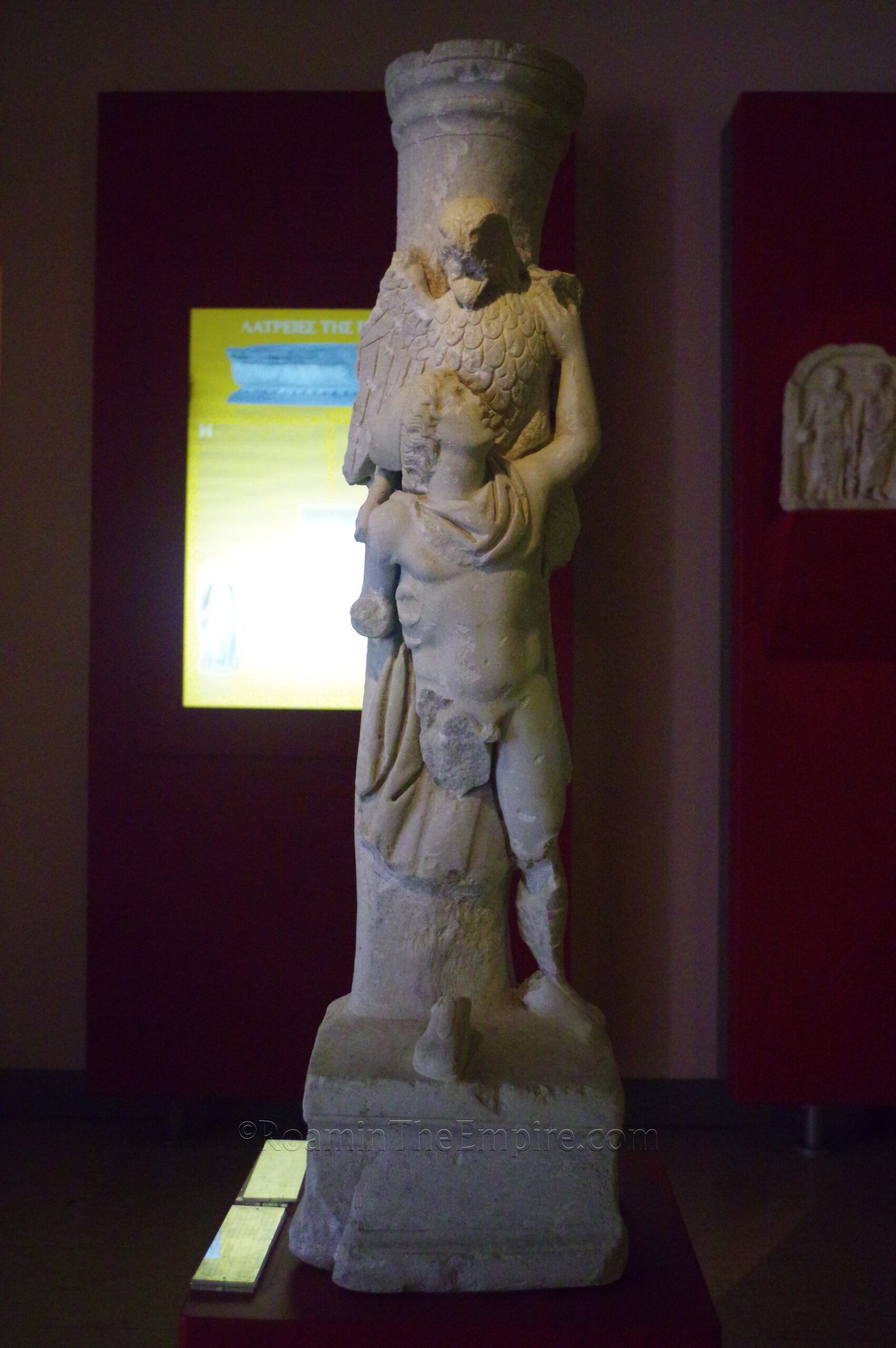
About a 10 minute walk to the southeast, at Leof. Anixeos 47, is the Archaeological Museum of Veria. The museum is open in the summer (April through October) daily from 8:00 to 20:00, except for Tuesday when it is open 12:00 to 20:00. The rest of the year it is open Wednesday through Monday from 9:00 to 17:00 and is closed on Tuesdays. Admission to the museum is 5 Euros in the summer and 2 Euros in the winter. A 17 Euro combination ticket can also be purchased which allows entrance (valid for 5 days) here and to the Byzantine Museum of Veria and the nearby Polycentric Museum of Aigai in nearby Vergina (which has some finds from Beroea).
The museum itself is not especially large, but it does have some very nice pieces. Some statuary and busts. A nice terracotta collection and other grave goods recovered from tombs. A few nice inscriptions and reliefs. One criticism is that it is perhaps one of the most poorly lit museums I can recall being in; the rooms were mostly dark with inadequate lighting; it wasn’t a particularly great viewing experience and made taking pictures a huge headache. Lots of information in English and Greek on display, though. The main museum took me about half an hour. Outside in the garden, however, was a fantastic exhibition poignantly titled ‘Wall of Memory’. Displayed there were at least 100 funerary stele with images of the inhabitants of Beroea; some simple portrait stele and others with scenes of their lives. All had descriptions in English and Greek. That part of the museum took another 20-30 minutes, for a total of about an hour there.
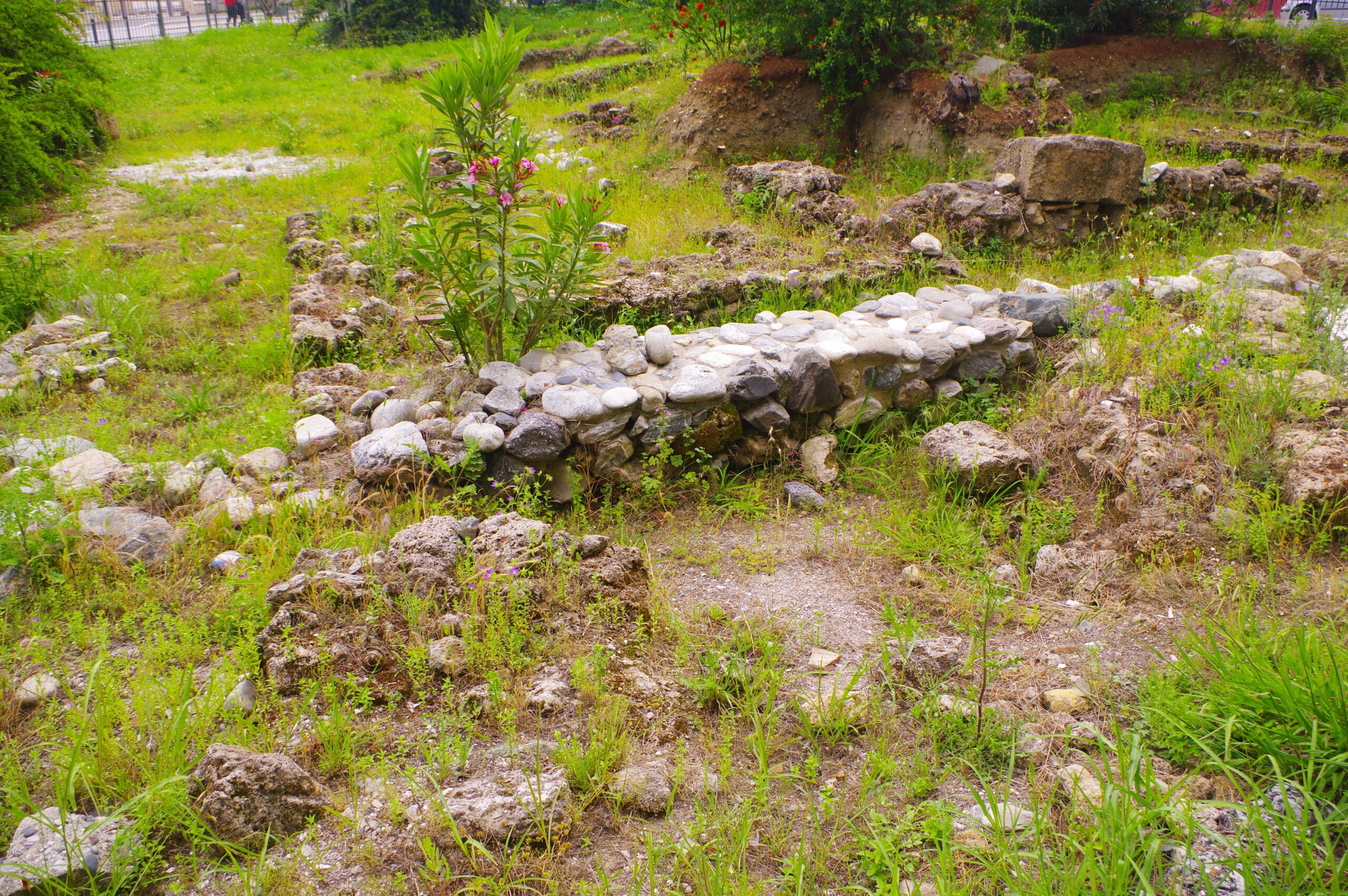
About 350 meters south on Leof. Anixeos, on the southwest corner of the intersection with Megalos Alexandros are a fenced set of remains. There’s no direct access, but it is visible from the street. It’s a bit overgrown and there isn’t a whole lot to see aside from a few walls and what appears to be some opus scutulatum pavement. This site is sometimes identified as a Roman bathing complex, though there does not seem to be much information available beyond that and none of the purpose built rooms are discernible. It may also be, according to a plan on display in the museum, something associated with the odeon of the city, though again, nothing really discernible is visible. While this site is marked on maps of the ancient city, there is nothing on-site marking it or providing any information about it.
A couple blocks west on Megalos Alexandros and then a block south on Eleftherios Venizelos is the Archaeological Site of Saint John the Merciful, so named because of the church that previously stood on this plot of land. The site is more or less open access. When the church was demolished, several earlier structures were found. While some vestiges of the 19th century church is clearly visible, this was also apparently the site of a public bathing complex, and some seemingly earlier walls likely belong to this. Once again, there is no on-site information and seemingly nothing available that details the ancient layers here.
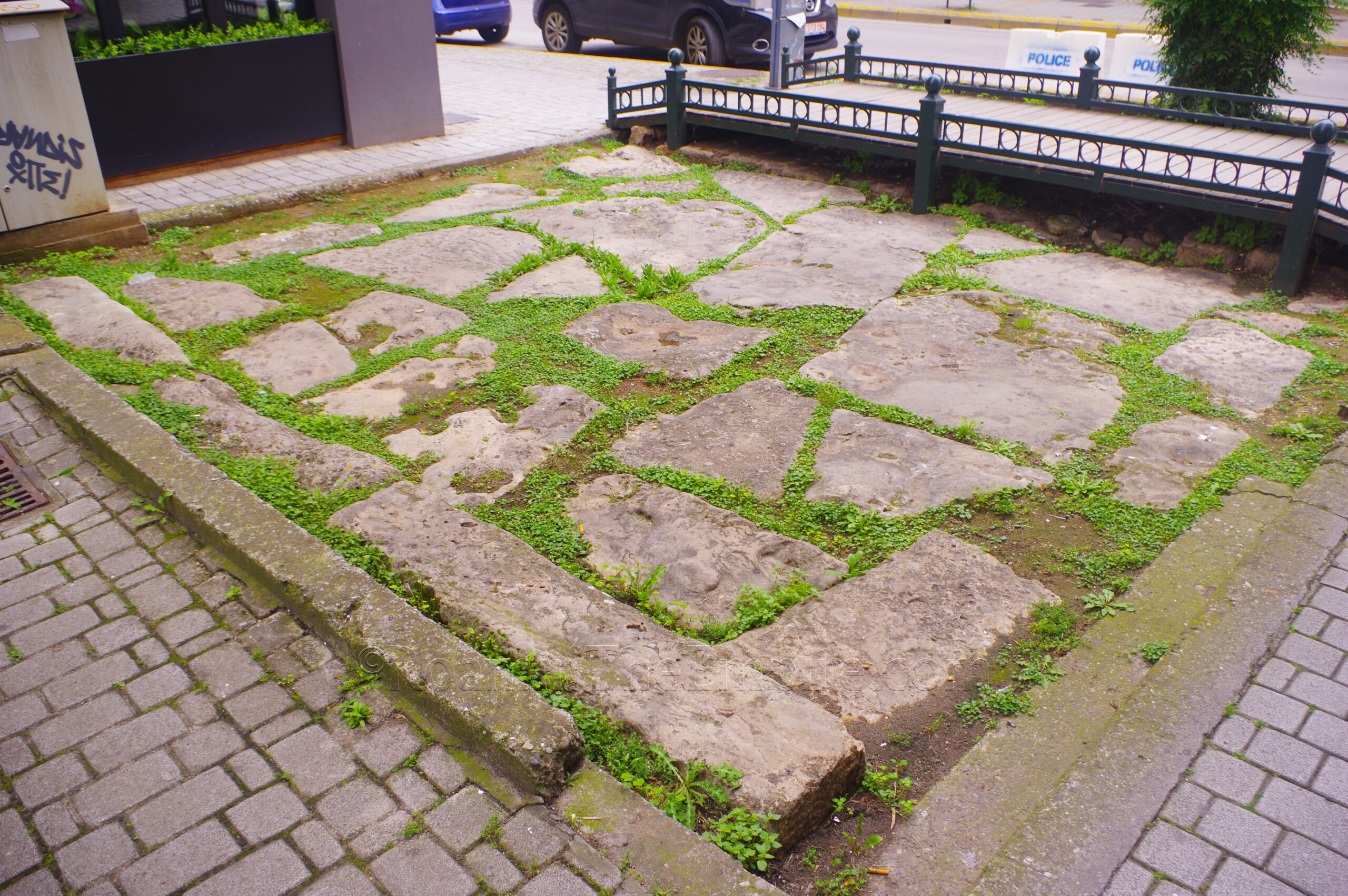
Another block south is Mitropoleos street, which now more or less follows the path of one of Beroea’s decumani. There are three points along Mitropoleos at which the 2nd-3rd century Roman road has been exposed and is visible between just before the intersection with Agiou Dimitriou and Loutrou. Several other roads have been identified and revealed, but they are not visible or accessible to the public. The final point near Loutrou is actually a fairly significant portion and preserve the umbones on one side. Cart ruts are also visible on the other two sections.
A couple blocks north of the middle road section, at Kentrikis 34, is the Old Metropolitan Church of Veria. Entrance is free and it is open in the summer (April through October) 8:00 to 20:00 daily except for Tuesday, when it is open 12:00 to 20:00. The rest of the year it is open daily 9:00 to 17:00 except for Tuesday, when it is closed. The church itself dates to the 11th century CE, but on display inside is an ancient funerary stele and the remains of marble doors from a Macedonian tomb. There is no information on either of them.
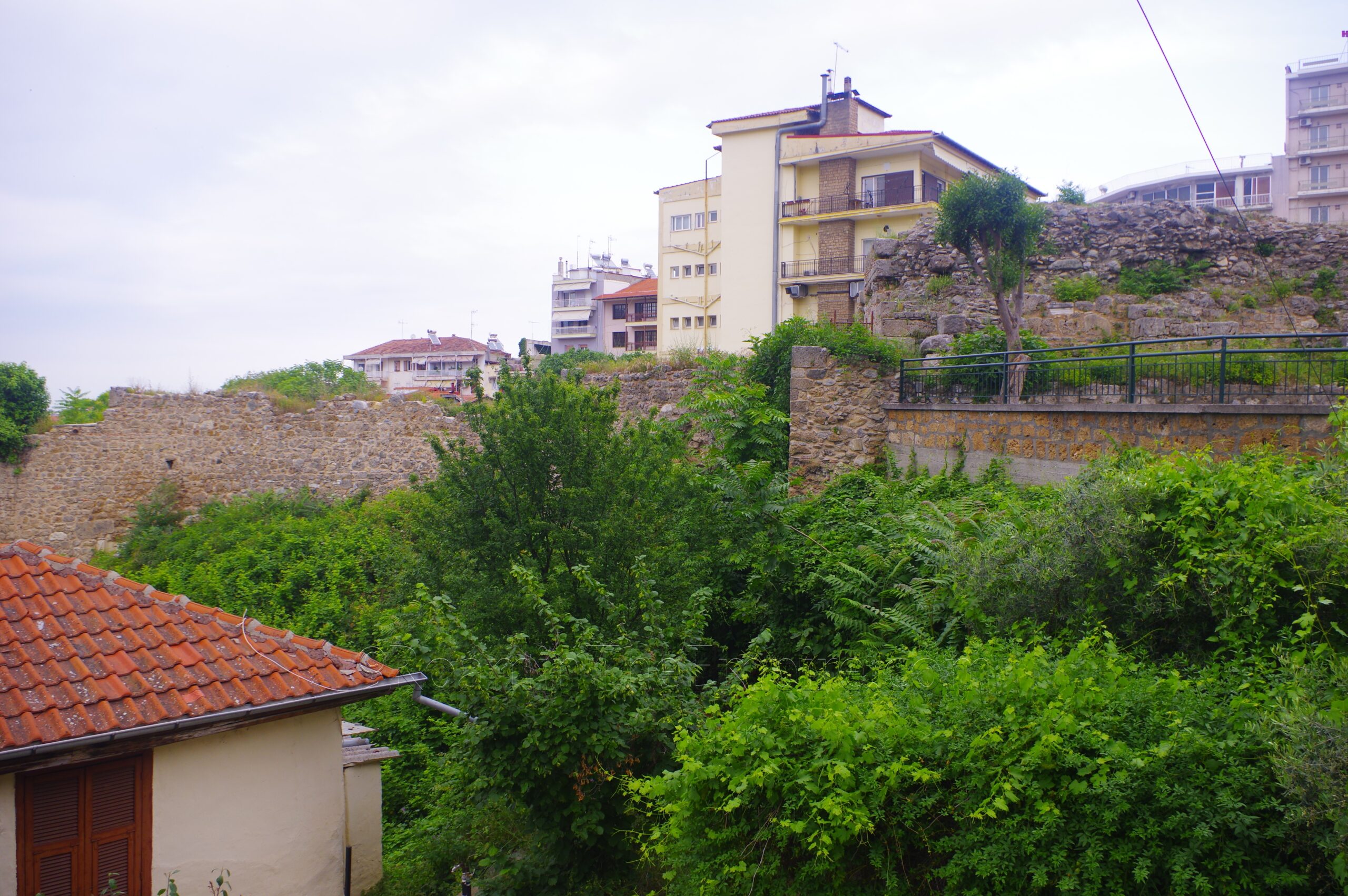
Heading back out to Mitropoleos and continuing south, the street essentially ends at Plateia Raktivan. On the northwest side of this square is a Byzantine tower built on the fortifications of the city. There are, of course, lots of later reconstruction and repair on this section of the western walls, but they constructed on the original Hellenistic and Roman fortifications of the city. Walking a little way down Verois street offers some views of the exterior of the walls that run adjacent to the tower.
Just a few minutes south of this section of the walls is the so-called Bema of the Apostle Paul. The courtyard in which it is located is open daily from 7:00 to 20:30 and there is no charge. Located in the courtyard is a large modern altar dedicated to Paul with three marble steps at the center. According to legend, these were part of the speaker’s platform from which Paul spoke after he fled Thessaloniki circa 51 CE. The steps do seem to date to the 1st century CE. The spot apparently had a sanctuary dedicated to Eunomia before a Christian church was built to house the artifact, which was later moved to its open air location.
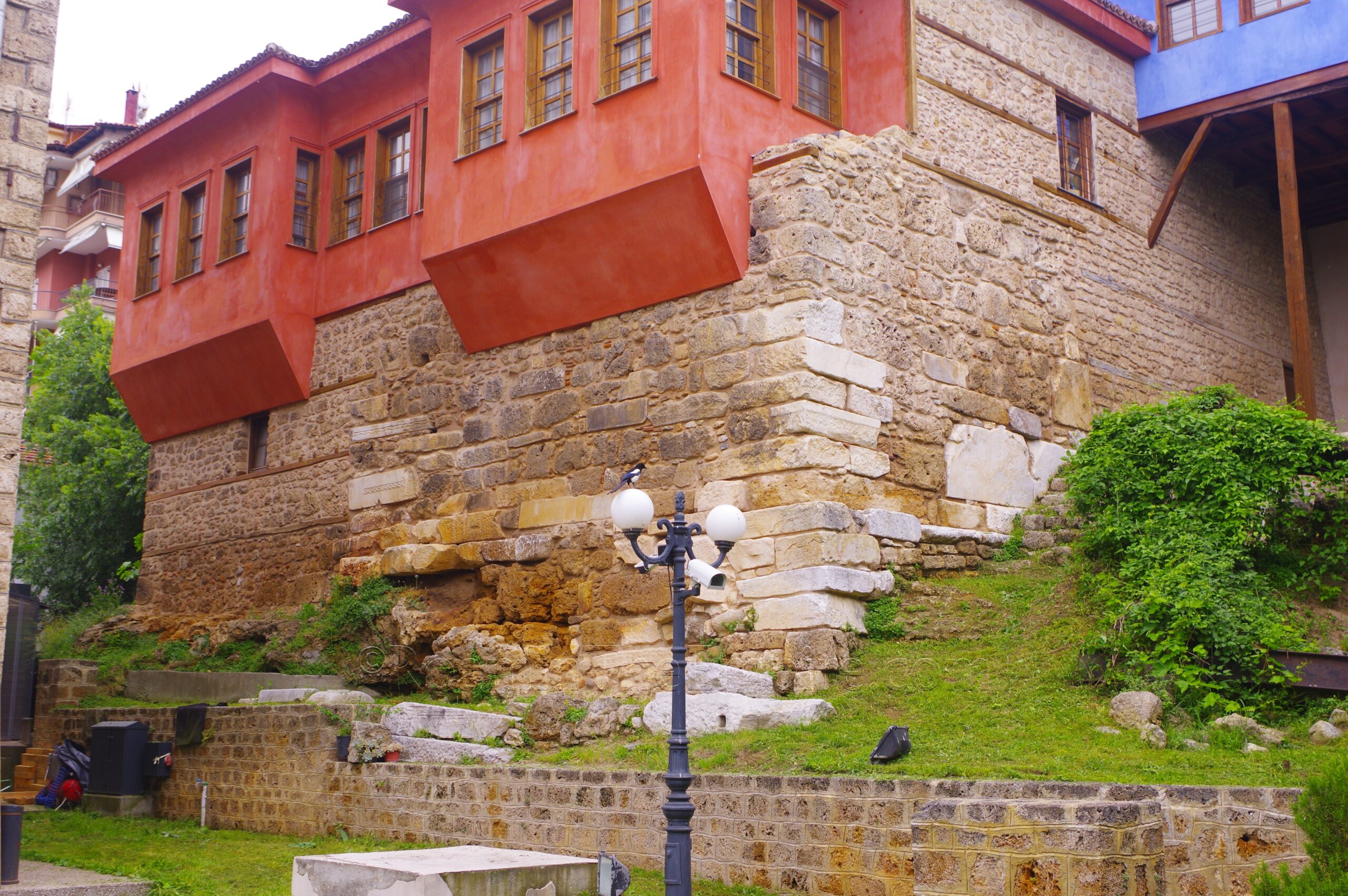
A major artery runs just to the east of the bema called Mpotsari Markou. A few blocks south along this street is a small street called Koloktroni, which almost immediately intersects with Karaiskaki, which then leads to the final point, the Byzantine Museum of Veria. Along these two roads, however, are some views of the eastern fortification walls of Beroea. Like those around Plateia Raktivan, there are later periods of composition on these walls as well. The circuit basically runs between the residential buildings in this neighborhood, so it is not directly accessible. It’s also only occasionally visible between the buildings and beneath overgrowth. There is one part along Koloktroni where the older blocks similar to the north walls can be seen, but they appear to be reused, rather than original.
The Byzantine Museum of Veria is located at Thomaidou 26. The building itself is part of a Byzantine tower and adjacent to the entrance and stretching to the east of the museum, a pretty good section of the ancient fortifications and very accessible. The museum is open daily in the summer from 8:00 to 20:00, except for Tuesday when it is open 12:00 to 20:00. The rest of the year it open daily from 9:00 to 17:00, except Tuesday when it is closed. Admission is 4 Euros, or is part of the combination ticket along with the Archaeolgical Museum of Veria and the Polycentric Museum of Aigai in Vergina for 17 Euros.
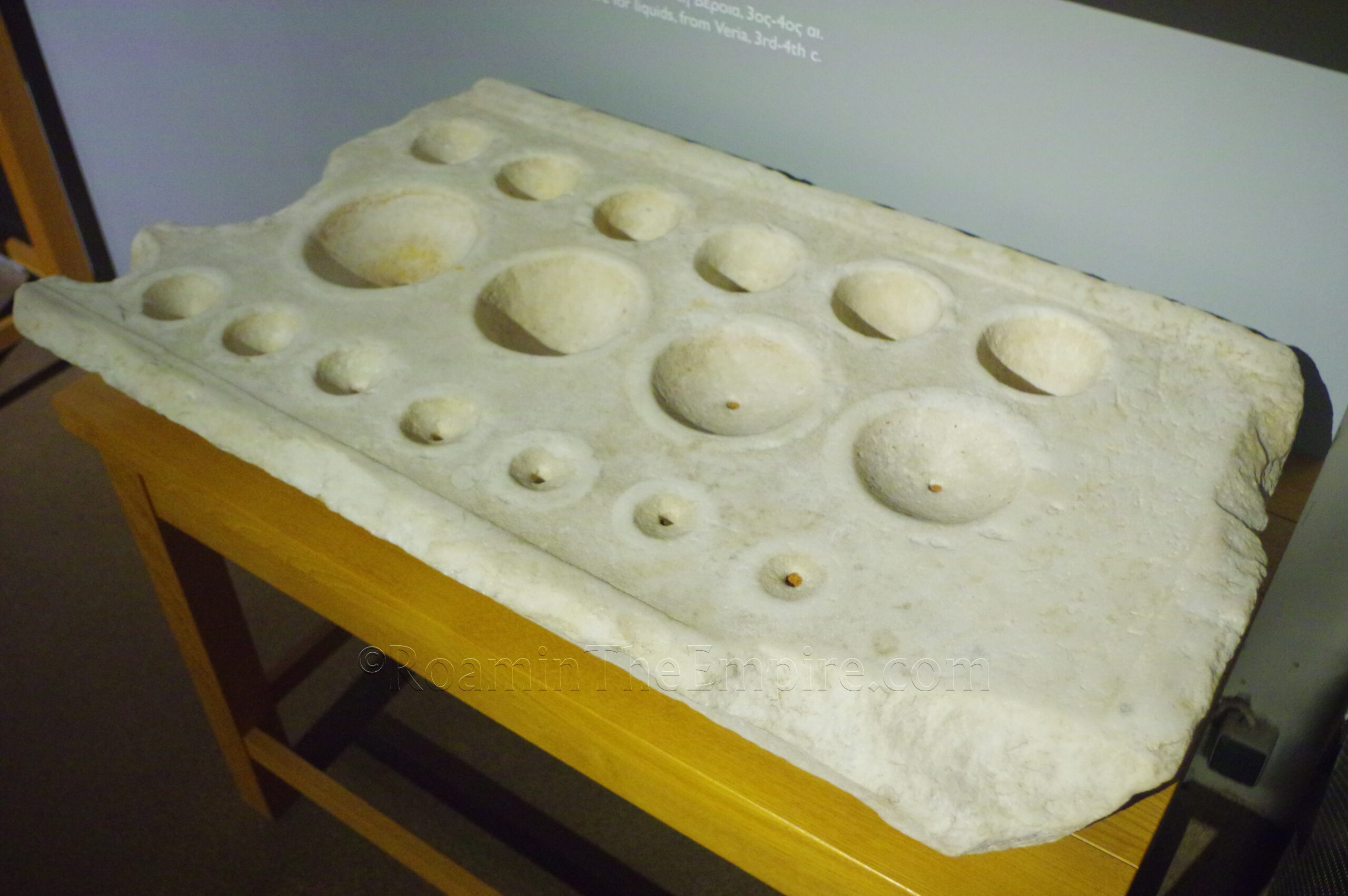
As the name would suggest, the vast majority of objects in the museum date later than the Roman period. But since the Greeks often consider the Byzantine period as starting about 300 CE, there’s a solid 150 years or so that falls under the Roman period. There are a couple mosaics dating as early as the 3rd century CE, a tomb from the 4th century CE, some other funerary objects from the 4th and 5th century CE, and a mensa ponderaria from the 3rd-4th century CE. It’s not a very big museum, though, but is certainly worth the stop if you’re interested in Byzantine material. If not, the combo ticket makes it worth a quick run through.
I visited Veria in conjunction with Vergina, and it was terribly difficult to fit the remains of ancient Beroea in the afternoon with your own vehicle; I suspect it would be more difficult to do them both with public transportation. I spent about three hours total there. The only things that really take up time are the museums, pretty much everything else is just a quick stop and there aren’t any organized archaeological sites.
Sources:
Grant, Michael. A Guide to the Ancient World: A Dictionary of Classical Place Names. New York: Barnes & Noble Books, 1997.
Livy. Ab Urbe Condita, 44.45.
Plutarch. Demitrius, 44.
Plutarch. Pyrrhus, 11.
Smith, William. Dictionary of Greek and Roman Geography. Walton & Murray, 1870.
Stillwell, Richard, William L. MacDonald, and Marian Holland. McAllister. The Princeton Encyclopedia of Classical Sites. Princeton, NJ: Princeton U Press, 1976.
Thucydides. Historia, 1.61.



2 thoughts on “Beroea, Macedonia”
Comments are closed.